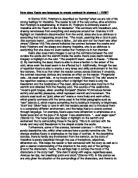How does Keats use language to create contrast in stanzas I – XVIII?
In Stanza XVIII, Porphyro is described as “burning” when we are told of his strong feelings for Madeline. The reader is told of the very active, alive emotions that Porphyro is experiencing. In Stanza IX, Porphyro is extremely aware of Madeline with his “heart on fire for Madeline”. This contrasts with Madeline’s cold, dreamy remoteness from everything and everyone around her. Stanzas V-VIII highlight on Madeline’s disconnection from the world, since she is so oblivious to everything that is happening around her. “The music, yearning like a God in pain, She scarcely heard….came many a tiptoe…but she saw not: her heart was other where” (Stanza VIII).This stanza indicates the contrast between the awake and lively Porphyro and the sleepy and dreamy Madeline, who is so oblivious to everything that she does not even realise that Porphyro is in her chamber.
Keats also uses many images to set up the contrasts between the cold outside the castle and the warmth inside the castle. Keats uses death-related imagery to highlight on the cold. “The sculptur’d dead…seem to freeze...” (Stanza II). By mentioning the dead, Keats is able to draw attention to the extent of the cold, since even the dead seem to be affected by it. Additionally, through the use of repetition Keats is able to create a very tense and chilly environment in the first few stanzas. This is so that when the reader comes across Stanzas V onwards, the contrast becomes obvious and creates an effect on the reader. “Purgatorial rails…his weak spirit fails…in icy hoods and mails.” (Stanza II) The ‘ails’ sound in the repetition creates a very lonely effect to highlight that there is only the Beadsman and the Sculptures of the dead, since everyone else must be in the warmth and shielded from the freezing cold. The sounds of the celebration, “music’s gold tongue; silver; snarling trumpets” (Stanza IV) introduce human activity and earthly pleasures, which represent warmth and movement. The colours used such as “gold, silver etc” create a more lively and warm effect, which greatly contrasts with the terms used in the initial paragraphs such as “wan” (stanza I), which means something that is lacking in intensity or brightness. ‘Gold’ and ‘Silver’ help to tune in with the readers senses and to introduce them to a completely different environment, and this helps Keats to create contrast through language. For example, Keats uses more alliteration to emphasise on a faster pace and on the joys of St Agnes’ Eves celebrations. “…ever eager eyed” (Stanza IV). The faster pace also helps to highlight on the warmth and excitement that is surrounding those in the party. This is in contrast with the lonely and very cold Beadsman in the chapel outside the castle.








